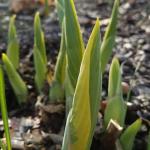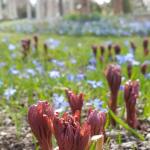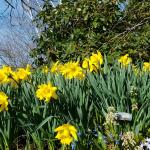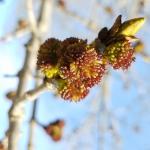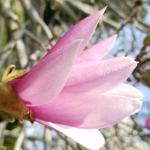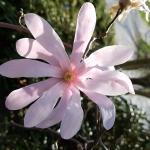UMass Extension's Landscape Message is an educational newsletter intended to inform and guide Massachusetts Green Industry professionals in the management of our collective landscape. Detailed reports from scouts and Extension specialists on growing conditions, pest activity, and cultural practices for the management of woody ornamentals, trees, and turf are regular features. The following issue has been updated to provide timely management information and the latest regional news and environmental data.
To read individual sections of the message, click on the section headings below to expand the content:
Scouting Information by Region
Environmental Data
The following data was collected on or about May 2, 2018. Total accumulated growing degree days (GDD) represent the heating units above a 50° F baseline temperature collected via our instruments for the 2018 calendar year. This information is intended for use as a guide for monitoring the developmental stages of pests in your location and planning management strategies accordingly.
|
MA Region/Location |
GDD |
Soil Temp |
Precipitation |
Time/Date of Readings |
||
|
1-Week Gain |
2018 Total |
Sun |
Shade |
|||
|
Cape Cod |
36 |
40.5 |
57 |
53 |
1.90 |
5:00 PM 5/2 |
|
Southeast |
32 |
60 |
66 |
56 |
2.25 |
5:10 PM 5/2 |
|
North Shore |
30 |
67 |
50 |
47 |
1.81 |
9:30 AM 5/2 |
|
East |
33.5 |
79.5 |
65 |
58 |
1.82 |
6:00 PM 5/2 |
|
Metro West |
22.5 |
47 |
50 |
48 |
1.82 |
5:30 AM 5/2 |
|
Central |
20 |
50 |
49 |
46 |
1.13 |
7:00 AM 5/2 |
|
Pioneer Valley |
38 |
66 |
56 |
51 |
1.60 |
12:00 PM 5/2 |
|
Berkshires |
24 |
53 |
54 |
48 |
1.10 |
9:00 AM 5/2 |
|
AVERAGE |
30 |
58 |
56 |
51 |
1.68 |
- |
|
n/a = information not available |
||||||
Phenology
| Indicator Plants - Stages of Flowering (BEGIN, BEGIN/FULL, FULL, FULL/END, END) | ||||||||
|---|---|---|---|---|---|---|---|---|
| PLANT NAME (Botanic/ Common) | CAPE | S.E. | N.S. | EAST | METRO W. | CENT. | P.V. | BERK. |
|
Chaenomeles speciosa (Common Flowering quince) |
Begin/Full |
Full |
Begin |
Begin/Full |
Begin |
Begin |
Begin/Full |
Begin |
|
Pyrus calleryana (Callery Pear) |
Begin/Full |
Full |
Begin/Full |
Begin/Full |
Begin |
* |
Full |
* |
|
Prunus serrulata (Japanese Flowering Cherry) |
Begin/Full |
Full |
Begin/Full |
Begin/Full |
Begin |
Full |
Full |
* |
|
Amelanchier spp. (Shadbush, Serviceberry) |
* |
* |
Begin |
Begin/Full |
Begin |
Begin |
Full |
* |
|
Rhododendron 'P. J. M.' |
Full |
Full |
Full |
Full |
Full |
Begin |
Full |
* |
|
Magnolia stellata (Star Magnolia) |
Full/End |
Full |
Full |
End |
Full |
Full |
Full |
Full |
|
Forsythia x intermedia (Border Forsythia) |
Full/End |
Full |
Full |
Full/End |
Full |
Full |
Full |
Full |
|
Rhododendron mucronulatum (Korean Rhododendron) |
Full/End |
Full |
Full/End |
* |
Full/End |
Full |
Full |
Begin/Full |
|
Pieris japonica (Japanese Pieris) |
Full/End |
Full |
Full |
Full |
Full/End |
Full |
Full/End |
Full |
|
Cornus mas (Cornelian cherry Dogwood) |
End |
Full/End |
Full/End |
End |
Full/End |
Full |
Full/End |
Full |
|
Acer rubrum (Red Maple) |
End |
End |
Full/End |
* |
Full/End |
Full/End |
Full/End |
Full |
| * = no activity to report/information not available | ||||||||
Regional Notes
Cape Cod Region (Barnstable)
General Conditions: Over the last week the temperature averaged 53°F with a high of 83°F on May 2 and a low of 38°F on April 30. A total of 1.9 inches of precipitation fell over April 25, 26, and 27. Topsoil and subsoil moisture conditions remain adequate. Finally, with a decent increase in GDD, plant development is starting to reach normal stages for this time of year.
Pests/Problems: Winter moth larvae have hatched and are feeding in the buds of susceptible host trees. Populations of winter moth seem to be significantly less than previous years. Other pests or damage observed over the last week include fungal needle casts (Bifusella linearis & Canavirgella banfieldii) on white pine, winter burn on white pine, winter burn on pitch pine, boxwood leafminer (Monarthropalpus flavus) damage and larvae on boxwood, volutella canker/blight on boxwood, winter injury & winter burn on boxwood, winter injury on rhododendron, fungal leaf spot on mountain laurel, hemlock elongate scale (Fiorinia externa) on hemlock, spruce spider mite (Oligonychus ununguis) on spruce, winter injury to butterfly bush (Buddleja davidii) and bigleaf hydrangea (Hydrangea macrophylla). The following weeds are in bloom: bittercress (Cardamine hirsute), mouse-ear cress (Arabidopsis thaliana), lesser celadine (Ranunculus ficaria) and dandelion (Taraxacum officinale). GDD 50 BE = 72, GDD 40 = 312
Southeast Region (Hanson)
General Conditions: Spring has arrived and summer looks to be right around the corner. The cooler, wet weather gave way to real heat (88 degrees) on May 2, with warmer weather in the forecast. It really is amazing what a few warm days will do and there is much more color in the landscape. With the heat, recently flowered tulips and daffodils are wilting, as are recently transplanted perennials. At this time (May 2), phenology is still behind last year. Hanson received 2.25 inches of rain. The following plants are in full bloom: Norway maple, Magnolia soulangiana (saucer magnolia), Magnolia stellata, Magnolia ‘Elizabeth’, Magnolia x loebneri ‘Leonard Messel’, Magnolia ‘Wada’s Memory’, Kwanzan cherry, cherry 'Holly Jolivette', Prunus serotina (black cherry), Corylopsis spicata, Corylopsis sinensis var. calvescens, Stachyurus praecox ‘Variegata’, Lindera benzoin (common spicebush), Salix sp. (pussy willow), Forsythia, PJM Rhododendron, Chaenomeles speciosa (common floweringquince), Pieris floribunda (mountain pieris), Pieris 'Brouwer's Beauty', Pieris japonica, Spiraea prunifolia f. simplicifolia (bridal wreath spirea), Spiraea thunbergii ‘Ogon’, azalea ‘April Snow’, Pachysandra terminalis, Pachysandra procumbens, Petasites japonicus (Japanese butterbur), Sanguinaria canadensis ‘Multiplex’ (double bloodroot), Helleborus xhybridus, Helleborus foetidus, Epimedium sp., Omphalodes verna, Primula sp, Glaucidium palmatum, Vinca, Pulmonaria, Trillium, Anemones, Brunnera macrophylla, Dicentra cucullaria (Dutchman’s breeches), violets, Muscari botryoides (grape hyacinth), daffodils and tulips. The following plants are beginning bloom: Dicentra spectabilis, Corydalis scouleri and Arisaema (Jack-in-the-pulpit). Lonicera fragrantissima (winter honeysuckle) and Cornus mas are ending bloom.
Lawns have greened up nicely and many are ready for mowing. Forsythia is still in bloom, and it is not too late for pre-emergence crabgrass applications. If using a preventative grub management product that contains Chlorantraniliprole (AceleprynTM, GrubEx), it is best applied before the end of May; follow the directions on the label before applying. Hummingbirds were observed in Hanson, MA on April 28th and Kingston, MA on May 1st. Right on schedule!
Pests/Problems: Winter moth caterpillars hatched in Hanson, approximately around April 27- 28th, as tiny 1st instar caterpillars were found May 1 in expanding foliage of Japanese maples (Acer triflorum) and oak. Buds on many oaks are still tight and on others, just about ready to expand. Although the forecast is for a reduced winter moth caterpillar population this year, continue to scout and monitor susceptible host plants, especially blueberry and apple, and manage if needed. Winter moth development, as well as other insect development, is behind schedule compared to previous years. No signs yet of gypsy moth egg hatch but that could change with the warm weather forecast this week. Please see the Insect section of the Landscape Message for winter moth and gypsy moth updates. Willow leaf beetles are active on willow. Lily leaf beetles have not yet been observed in Hanson but continue to monitor lilies for them, as they should soon be active. Manage early to avoid significant damage to true lilies. Continue to monitor hemlocks for hemlock wooly adelgid and also for elongate hemlock scale (Fiorina externa). Also monitor for Elongate hemlock scale on fir (Abies spp) and spruce (Picea spp.) Monitor pines for pine needle scale and monitor spruce, fir, hemlock, arborvitae, etc. for spruce spider mite. Continue to monitor hard-needled pines like Mugo for European pine sawfly and manage early if found. Bacillus thuringiensis (Bt) does not work on sawfly larvae. The following insects are active: deer ticks, bumblebees, ants, honeybees, boxelder bugs, slugs, gnats, black flies and mosquitoes. Dandelion, violet, and Ranunculus ficaria are in bloom. Bittercress remains in bloom and is also setting seed. Voles were active on the crowns of Hosta and Epimedium last winter as is evidenced by the reduced shoots emerging and gnawed crowns. Deer, turkeys and chipmunks remain active.
North Shore Region (Beverly)
General Conditions: Seasonable spring conditions persisted most of this reporting period, but a warm weather system brought some summer-like temperatures in the days of the reporting period. Temperatures were in mid-50s to mid-60s in the first half of the reporting period but they rose to low 80s by mid-week. During the past seven days we added 30 growing degree days for a total of 67 growing degree days at Long Hill. Approximately 1.81 inches of rain were recorded at Long Hill. Soils are moist and suitable for planting. Most gardeners are planting the season’s crops such as leafy greens. Woody plants that are beginning to bloom or continue to bloom include: Winter honeysuckle (Lonicera fragrantissima), fragrant viburnum (Viburnum farreri), red maple (Acer rubrum), Cornelian cherry dogwood (Cornus mas), serviceberry (Amelanchier arborea), weeping Higan cherry (Prunus subhirtella), mountain pieris (Pieris floribunda), Kwanzan cherry (Prunus serrulata), star magnolia (Magnolia stellata), Korean rhododendron (Rhododendron mucronulatum), Callery pear (Pyrus calleryana), spring flowering herbaceous plants seen in full bloom include: daffodils (Narcissus spp.), bloodroot (Sanguinaria canadensis), crocus (Crocus spp.), Japanese wood poppy (Glaucidium palmatum), pachysandra(Pachysandra procumbens), vinca vine (Vinca minor) and tulips(Tulipa spp).
Pests/Problems: Yellow buttercup weed (Ranunculus ficaria) is in full bloom. Other weeds seen in bloom include dandelion (Taraxicum officinale) and purple deadnettle (Lamium purpurea). Norway maples (Acer platanoides) are also in full bloom with yellowish-green flowers all over the landscape (Norway maple is invasive). Twig blight of juniper was also observed on some juniper trees. Twig blight of juniper is caused by Phomopsis or Kabatina fungi. Prune and destroy infected twigs. Send a sample to UMass Extension's Plant Diagnostic Lab to confirm which fungus is present. Because of the warm temperatures, ticks are very active. Be careful to protect yourself when working outdoors.
East Region (Boston)
General Conditions: The landscape has been transformed since last week. Temperatures have been consistently warm with highs that ranged from 50°F to 74°F, averaging 63°F and lows that ranged from 38°F to 52°F, averaging 45°F. We gained GDDs on six of the past seven days, accumulating 33.5 GDDs and bringing the total to 79.5 so far this year. Over the past week we received rain on five days with the majority falling on the 25th/26t accounting for 1.17 inches out of a total of 1.82 for the entire week. Lilac buds had just begun to open last week. This week early lilac (Syringa oblata) is in flower. Turf is greening up and will soon require mowing.
Woody plants in bloom include: Amelanchier arborea (common serviceberry), A. canadensis (eastern shadbush), Carpinus japonica (Japanese hornbeam), Chaenomeles japonica (Japanese flowering quince), C. speciosa (common flowering quince) cultivars ‘Candidissima’, ‘Cardinalis’, ‘Nivalis’, and ‘Rubra Grandiflora’, C. x superba (quince), Corylopsis sinensis var. sinensis (Chinese winter hazel), C. gotoana (dwarf winterhazel), Kerria japonica (Japanese kerria), Lindera benzoin (spicebush), Magnolia bohuashense, M. x soulangeana 'Candolleana' (saucer magnolia), M. stellata (star magnolia) and cultivars 'Centennial' and 'Rosea', M. cultivars ‘Betty’, ‘Elizabeth’, ‘Galaxy’, and ‘Randy’, Malus spectabilis (Chinese flowering crabapple), Oemleria cerasiformis (osoberry or Indian plum), Prunus alleghaniensis var. davisii (Davis Allegheny plum), P. cerasifera ‘Atropurpurea’ (Pissard plum), P. cyclamina (cyclamen cherry), P. nigra (Canada plum), P. nipponica (Japanese alpine cherry), P. padus (European bird cherry), P. sargentii (Sargent cherry) and its cultivar ‘Columnaris’, P. serrulata 'Washi-no-o' (Oriental cherry), P. subhirtella ‘Pendula’ (weeping Higan cherry), P. x hillieri ‘Spire’ (Hillier cherry), P. x juddii (Judd cherry), P. ‘Accolade’ and ‘Karl Sax’, Pyrus pyrifolia (Chinese pear), Rhododendron ‘Vallya’ (Lepidote rhododendron), Ribes aureum (golden currant), R. fasciculatum var. chinense (Chinese winterberry currant), R. lacustre (bristly swamp currant), R. uva-crispa (gooseberry), Spiraea prunifolia (bridalwreath spirea), S. × arguta (garland spirea), Syringa oblata (early lilac), Vaccinium corymbosum (highbush blueberry), Viburnum furcatum (forked viburnum), V. lantanoides (hobblebush), Xanthorhiza simplicissima (yellowroot) and Zabelia biflora. Herbaceous plants in bloom include: Anemone nemorosa (wood anemone), Corydalis solida (fumewort), Epimedium x rubrum (red barrenwort), Muscari sp. (grape hyacinth), Narcissus sp. (daffodil), Trillium grandiflorum (white trillium), Uvularia grandiflora ‘Sunbonnet’ (largeflower bellwort), Viola pubescens (Downy yellow violet), and V. sororia (common blue violet).
Pests/Problems: Landscape weeds are thriving. Glechoma hederacea (ground ivy), Lamium purpureum (purple deadnettle) and Taraxacum sp. (dandelion) are flowering in unmanaged turf. Urtica dioica (stinging nettle) is 6-8 tall. Alliaria petiolata (garlic mustard) flower stalks have elongated and flower buds are visible. Ficaria verna (lesser celandine) has formed masses in mulched beds, turf and along many wetlands; it continues to flower profusely. The chartreuse colored flowers of Norway maple (Acer platanoides) are visible from a distance. There has been considerable frog singing over the last couple of days.
Metro West (Acton)
General Conditions: With the recent rain and warm weather, lawns are greening up and growing and leaves and flower buds are expanding. Day length is increasing by 2 or more minutes daily and will be at 14 hours and 14 minutes come tomorrow, May 5th. Precipitation has been recorded for this area on five of the past seven days for a total of 1.82”, bringing our total rainfall recorded for the month of April to 5.24”, thereby surpassing the monthly average of 4.16”! The landscape is filled with color and in some stage of bloom at this time are the following woody plants: Acer rubrum (red maple), Amelanchier spp. (shadbush, serviceberry), Cercis canadensis (redbud), Chaenomeles speciosa (common flowering quince), Cornus mas (Cornelian cherry dogwood), C. officinalis (Japanese Cornelian cherry), Forsythia spp. (Forsythia), Lindera benzoin (common spicebush), Magnolia stellata (star magnolia), Magnolia x loebneri 'Merrill', (Merrill magnolia), Pieris japonica (Japanese pieris), Prunus spp. (cherry), Pyrus spp. (pear), Rhododendron mucronulatum (Korean rhododendron), R. 'P. J. M.' (PJM Rhododendron), and Spirea thunbergii (Thunberg spirea). Contributing even more color and interest to the landscape are some flowering herbaceous plants and spring ephemerals including: Anemone nemorosa (wood anemone), Asarum europaeum (European ginger), Caltha palustris (marsh marigold), Claytonia virginica (Virginia spring beauty), Dicentra canadensis (squirrel corn), D. cucullaria (Dutchman's breeches), Chionodoxa luciliae (glory of the snow), Epimedium versicolor 'Sulphureum' (yellow flowering barrenwort), Erythronium americanum (yellow trout-Lily), Helleborus niger (Christmas rose), Hyacinthus spp. (hyacinth), Jeffersonia diphylla (twinleaf),Mertensia virginica (Virginia bluebells), Muscari sp. (grape hyacinth), Narcissus spp. (daffodil), Omphalodes verna (blue-eyed mary), Pachysandra procumbens (Allegheny spurge),P. terminalis (Japanese pachysandra), Phlox subulata (moss phlox), Primula spp. (primrose), Pulmonaria longifolia (lungwort), P. rubra (salmon-colored lungwort), Puschkinia libanotica (striped squill), Sanguinaria canadensis (bloodroot), S. canadensis 'Multiplex' (double bloodroot), Scilla siberica (Siberian squill), Tulipa spp. (tulip), Vinca minor (periwinkle), Viola spp. (violet) and Waldsteinia ternata (barren strawberry).
Pests/Problems: Acer platanoides (Norway maple) is in full bloom. This invasive tree is hard to miss now that it is in bloom, can be identified by its flowers that are yellowish-green and can be found growing most anywhere along roadsides and in abandoned lots. Other weeds seen in bloom but without the invasive tendency of the previous one mentioned are: Lamium purpureum (purple deadnettle) and Taraxacum officinale (dandelion). Ticks are active so monitor yourself and others for these parasites. Wear light color clothing to make the job easier on you. Black flies are active as well.
Central Region (Boylston)
General Conditions: What a difference a week makes! Many new plants are in bloom such as Virginia bluebells (Mertensia virginica). Tulips are just beginning and daffodils are almost at peak. Magnolias (Magnolia × lobneri ‘Merrill’ and Magnolia × lobneri ‘Leonard Messel’) are in full bloom. Magnolia × soulangeana ‘Alexandrina’ and anise magnolia (Magnolia salicifolia) are just beginning. Ash (Fraxinus sp.) flower buds are beginning to expand. Many herbaceous plants are pushing foliage such as peonies (Paeonia cultivars and sp.), monkshood (Aconitum × carmichaelii ‘Barker's Variety’) and hosta.
Pests/Problems: Black fly season is beginning, winter annual weeds like winter cress are flowering, and invasive garlic mustard (Alliaria petiolata) are showing basal foliage and seeds are germinating. Leaves are beginning to show on oriental bittersweet (Celastrus orbiculatus) and burning bush (Euonymus alatus)
After another 1.13” of rain over the last week, the grounds and turf are very saturated and with turfgrasses beginning active growth this will be a challenge to mow in some areas.
Winter burn injury on some plants like boxwood (Buxus) and roses (Rosa) is noticeable and will be pruned off in the next few weeks. Watching Gypsy moth egg masses for hatching, hatch has just begun as of Thursday 5/3... see the Insect Section of the Message below for additional information.
Pioneer Valley Region (Amherst)
General Conditions: Leaf-out is happening at a rapid rate after warming temperatures and additional rainfall took place over this past week. Many trees and shrubs now have tender foliage, including maple, elm, beech, oak, viburnum, ironwood, yellowwood, larch, serviceberry, among many others. Crabapples are ahead of the pack right now, providing the only meaningful shade in the landscape as we adjust to the increasing intensity of the sun. Purple-flowered PJM rhododendrons are in full bloom and are attracting large numbers of bees. High temperatures continued to change dramatically from day to day during this reporting period, ranging from 51° to 88°F. Low temperatures have stayed well above freezing in the valley but the threat of frost remains based on historical records. The tri-county region received over 5.5” of rain in many locations during the month of April and soils remain moist and prime for planting at this time. Soil temperatures continue to steadily climb, with the shade reading now over 50°F. The long-term forecast, as we settle into May, calls for additional rainfall in the form of thunderstorms and passing showers. Despite the unseasonably cold start to April, many spring-flowering trees and shrubs are blooming at their normal time. Lawns continue to green and grow at a rapid pace and many have received at least one mowing at this time.
Pests/Problems: Phyllosticta leaf blotch is common at this time on Ilex species, especially American holly (I. opaca). The tan to black-colored spots and blotches on the foliage can significantly reduce the aesthetic value of landscape trees and shrubs. Rust pathogens in genus Gymnosporangium are now active on the landscape. The cedar-apple rust (Gymnosporangium juniperi-virginianae) and cedar-hawthorn rust (G. globosum) pathogens produce rounded galls on shoots and branches of Juniperus. Presently, dark red spore masses (telia) are swelling and will gelinatize and disperse during the next rain event. The cedar-quince rust pathogen (G. clavipes) is far more destructive on Juniperus, producing cushion-like masses of spores that encircle stems and branches. The ensuing cankers can girdle stems outright or become perennial sources of inoculum as the stem or branch survives. The spore pads have ruptured through the bark and are brick-red in color. After the next rain event, they will become orange and gelatinous, dispersing large numbers of spores that can infect an array of rosaceous hosts. Serviceberry can be particularly hard hit as the fungus produces stem cankers that can reduce vigor and cause canopy dieback. Spruce and Douglas-fir buds continue to swell but have not yet broken on trees scouted in Hampshire County. Once new growth is approximately 0.5” in length, fungicide application can commence to help control the various needle cast fungi that are problematic on these trees. Unlike many other commercial products that portend to “expire” over time, sunblock does lose its functionality with age. Now is a good time to restock for the season to avoid sunburn and the dangerous aftermath in future years. Spring is here! Unfortunately, so are the mosquitoes and, albeit briefly, the black flies. Patrol properties to overturn any receptacles harboring stagnant water that may serve as egg-laying sites for mosquitoes. Skunks are still actively ravaging lawns in search of maturing grubs. There are several Bt-based products available for controlling grubs in turf grass settings for those that aren’t interested in the insecticides routinely used for these pests. Now that annuals and herbaceous perennials are abundant on the landscape, rabbits are doing what they do best, destroying them! It’s particularly frustrating when rabbits don’t actually eat a flower, but simply clip the stem and leave the flower laying nearby. Deer repellents, such as Deer Off, work very well against these smaller members of the landscape. If you find an embedded tick, submit it to the UMass Laboratory of Medical Zoology to have it screened for any pathogens that it might harbor. The list of tick-borne pathogens continues to increase and extends far beyond the Lyme disease pathogen.
Berkshire Region (Great Barrington)
General Conditions: What a week! Cool, wet weather dominated the period from Wednesday, April 25 through April 30. The last two days of April experienced early morning temperatures in mid-30s with heavy wet snow. The snow mixed with rain and did not accumulate. The arrival of May changed the scenario from late winter-like conditions to mid-summer-like conditions. At the moment, May 2nd, thermometer readings are in mid 80s. With high soil moisture levels and warmth, plant growth will accelerate. Grass, especially, is rapidly growing and ready for mowing. Spring flowering bulbs still dominate the garden scene with daffodils (Narcissus spp.) most prominent. Other bulbs in bloom are Siberian squill (Scilla siberica), striped squill( Puschkinia scilliodes) and glory of the snow (Chionodoxa luciliae). Herbaceous plants in bloom include hellebores (Helleborus spp.), marsh marigold (Caltha palustris), periwinkle (Vinca minor), lungwort (Pulmonaria longifolia), and pachysandra (Pachysandra terminalis). Star magnolia (Magnolia stellata) is quite common in home landscapes, but the Loebner magnolia (Magnolia x loebneri 'Merrill') is seemingly as prominent.
Pests/Problems: Pest activity is picking up though not quite a major issue. Spruce spider mites were detected on dwarf Alberta spruce (Picea glauca 'Conica’). The larvae of boxwood leaf miner are now feeding between the upper and lower surfaces of boxwood leaves. Blisters on the underside of leaves are an indication of leaf miner presence. A hard pruning of boxwood now can reduce some of the leaf miner population but a severe pruning in June after the adults have completed their egg laying on new growth in June. Black-legged ticks are a serious concern for anyone spending time outdoors. The reports of tick attachment remain at a high level. Other insects around at this time are more of the nuisance type, i.e. eye gnats, black flies, and wasps. Sowbugs and pillbugs can be found in abundance beneath leaves and other debris. Thus far, very little winter injury has been seen on evergreen plant material.
Regional Scouting Credits
- CAPE COD REGION - Russell Norton, Horticulture and Agriculture Educator with Cape Cod Cooperative Extension, reporting from Barnstable.
- SOUTHEAST REGION - Deborah Swanson, UMass Extension Horticulturist for Plymouth County - Retired, reporting from Hanson.
- NORTH SHORE REGION - Geoffrey Njue, Green Industry Specialist, UMass Extension, reporting from the Long Hill Reservation, Beverly.
- EAST REGION - Kit Ganshaw & Sue Pfeiffer, Horticulturists, reporting from the Arnold Arboretum, Jamaica Plain.
- METRO WEST REGION - Julie Coop, Forester, Massachusetts Department of Conservation & Recreation, reporting from Acton.
- CENTRAL REGION - Dawn Davies, Interim Horticulture Manager, reporting from Tower Hill Botanic Garden, Boylston.
- PIONEER VALLEY REGION - Nick Brazee, Plant Pathologist, UMass Extension Plant Diagnostic Lab, reporting from UMass Amherst.
- BERKSHIRE REGION - Ron Kujawski, Horticultural Consultant, reporting from Great Barrington.
Woody Ornamentals
Diseases
Rhizosphaera needle cast of blue spruce (Picea pungens), Oriental spruce (P. orientalis) and true fir (Abies sp.) Several blue spruce samples, in addition to the Oriental spruce and true fir. Trees range in age from 15- to 50-years-old and reside in various landscape settings. On some of the blue spruce samples, stem cankering caused by Phomopsis and Botryosphaeria was also present, in addition to one sample that was also harboring Stigmina needle cast. Symptoms of infection include death and premature shedding of older needles, especially those on shaded, interior canopy branches. Needle cast fungi do not kill trees outright but can dramatically reduce annual growth, making trees more susceptible to drought and attack by secondary insects and pathogens. http://ag.umass.edu/landscape/fact-sheets/rhizosphaera-needle-cast
Arborvitae needle blight caused by Phyllosticta thujae and Pestalotiopsis on emerald green arborvitae (Thuja occidentalis ‘Smargd’). Many trees, approximately 10-years-old, planted seven years ago as a residential border screen. In 2017, two trees began developing symptoms consistent with arborvitae needle blight (browning needle tips, premature needle shedding and branch dieback). The symptomatic trees were replaced but now symptoms are developing on other trees in the screen. When Phyllosticta and Pestalotiopsis co-occur, significant damage can take place. http://ag.umass.edu/landscape/fact-sheets/arborvitae-needle-blight
Report by Nick Brazee, Plant Pathologist, UMass Extension Plant Diagnostic Lab, UMass Amherst.
Insects
Woody ornamental insect and non-insect arthropod pests to consider, a selected few:
- Gypsy Moth: (Lymantria dispar) Overwintered egg masses laid by female moths in 2017 can be seen in certain areas of the state at this time. Egg masses are “fuzzy” or hairy and brownish-tan in color. Each egg mass can hold up to 500-1000 eggs. These masses may be found on host plant trunks and branches such as oak (favored), maple, birch, poplar, and many others, but are also laid on inanimate objects including the surfaces of homes, outdoor furniture, camping equipment, firewood piles, etc. This may make the accidental movement of gypsy moth egg masses possible.
Gypsy moth egg hatch has been observed in Boylston, MA (Worcester County) as of 2:00 PM on 5/3/2018. This same location was checked on 5/2/2018, and hatch had not yet begun. With the high temperatures the past two days, growing degree day accumulations have accelerated. Gypsy moth egg hatch typically occurs between 90-100 Growing Degree Days, using a base of 50°F and average temperatures. This is usually around the first week in May in Massachusetts, but variations in temperature may lead to early egg hatch in the last week in April. This can also coincide with serviceberry (Amelanchier) bloom. A location in Belchertown, MA that had a high population of gypsy moth caterpillars in 2017 was checked again on 5/1/2018. Due to the gypsy moth caterpillar-killing fungus (Entomophaga maimaiga), the population at that specific location seems to have collapsed, and very few egg masses were found. At a location in Amherst, MA checked on 5/1 and 5/3/2018, significant numbers of gypsy moth egg masses were located. None of the egg masses have hatched yet at that location as of May 3rd. With the summer-like temperatures predicted for many areas of Massachusetts at this time, locations that have not already accumulated enough GDD’s for gypsy moth egg hatch may do so quickly. We will continue to monitor egg masses and report observed egg hatch at any of our monitored locations as it occurs.
After egg hatch, groups of tiny gypsy moth caterpillars may remain on their egg mass just before crawling to the canopy of their host plant, where they can disperse using a technique known as “ballooning”. Ballooning occurs when very young caterpillars spin a silken thread and catch the wind to blow onto a new host plant once the thread breaks. This method of dispersal can lead to host plants becoming defoliated that previously did not have egg masses directly on them. Egg masses may be present on nearby oaks, for example, and provide a local population of caterpillars.
Despite the fungal outbreak that swept through the 2017 caterpillar population, some lucky caterpillars survived to pupation and emerged as adult moths. (However, adults were present in 2017 in far fewer numbers than would have existed without the fungus.) While it is very difficult to predict how much defoliation Massachusetts will see in 2018 due to gypsy moth caterpillar feeding, we can be certain that in areas where many egg masses are currently seen overwintering, pockets of defoliation could still occur in certain areas of the state this year. Thanks to the gypsy moth caterpillar-killing fungus, however, the population should be on the decline, but we cannot expect the caterpillars to disappear completely from Massachusetts landscapes this season.
- Winter Moth: (Operophtera brumata) The winter moth population is at a record low! The 2018 outlook concerning winter moth caterpillar population numbers in Massachusetts is very positive for those of you in the eastern areas of the state accustomed to dealing with damaging populations of this insect. Dr. Joseph Elkinton, Professor of Environmental Conservation at the University of Massachusetts, Amherst, MA, has excellent news: data from his lab’s research locations in eastern Massachusetts suggest that this invasive pest’s population size is at an all-time low. In fact, the 2017 winter moth population was the lowest they have seen since studying and working toward the biological control of this insect for the past 13 years.
In Barnstable, MA, winter moth caterpillars were detected in crabapple buds on 4/23/18. Winter moth caterpillars were reported in the buds of Japanese maple and three-flowered maple (Acer triflorum) in Hanson, MA on 5/1/2018. Although it is predicted that winter moth caterpillar populations will be reduced this year, it is recommended that you monitor host plants for the presence of winter moth caterpillars. For region-specific information, see the Scouting Reports above.
In landscape settings in eastern Massachusetts, there may still be small, pocketed areas where ornamental trees and shrubs need protection from winter moth in 2018. For protection in landscapes, it is best to wait until the leaves of susceptible hosts completely unfold and monitor for feeding caterpillars, prior to treatment, especially since populations in Massachusetts are so low this year. For more information about the life cycle and management of winter moth, please visit thisfact sheet: Winter Moth Identification and Management ( https://ag.umass.edu/landscape/fact-sheets/winter-moth-identification-management ).
Winter moth is a non-native insect that was identified in Massachusetts for the first time in 2003 following persistent reports of defoliation in eastern areas of the state such as Cape Anne and on the North Shore near Cohasset, Hingham, and Rockland on the South Shore in the late 1990’s. For more detailed information about the history of this insect pest in North America and Massachusetts, please visit this fact sheet: Winter Moth in Massachusetts: History and Biological Control ( https://ag.umass.edu/landscape/fact-sheets/winter-moth-in-massachusetts-history-biological-control ).
This fact sheet also includes updates regarding the progress of the work of Dr. Joseph Elkinton’s laboratory group at the University of Massachusetts and their efforts toward the biological control of winter moth using Cyzenis albicans, a tachinid fly. The fly parasitizes the caterpillars of winter moth specifically. In other areas, such as Nova Scotia where winter moth was also problematic, this fly used for biological control has been successful in reducing winter moth to a non-pest. C. albicans has been released across 43 sites in Massachusetts and has been established in at least 32 of those locations as evidenced through the recovery of flies in winter moth in subsequent years. The Elkinton Lab now has data showing that at six of these locations (Falmouth, Hanson, Hingham, Wellesley, Wenham, and Yarmouth, MA) the fly populations have increased alongside an observed decrease in the winter moth population there. For more information about the progress of winter moth biological control in Massachusetts, visit the following article in Hort Notes found under “Trouble Maker of the Month”, here: https://ag.umass.edu/landscape/newsletters/hort-notes/hort-notes-2018-vol-292 .
- Asian Longhorned Beetle: (Anoplophora glabripennis, ALB) Look for signs of an ALB infestation which include perfectly round exit holes (about the size of a dime), shallow oval or round scars in the bark where a female has chewed an egg site, or sawdust-like frass (excrement) on the ground nearby host trees or caught in between branches. These particular signs of damage from the beetle may be more visible at this time of year, when host trees such as maples are first leafing out. Be advised that other, native insects may create perfectly round exit holes or sawdust-like frass, which can be confused with signs of ALB activity.
The regulated area for Asian longhorned beetle is 110 miles2 encompassing Worcester, Shrewsbury, Boylston, West Boylston, and parts of Holden and Auburn. If you believe you have seen damage caused by this insect, such as exit holes or egg sites, on susceptible host trees like maple, please call the Asian Longhorned Beetle Eradication Program office in Worcester, MA at 508-852-8090 or toll free at 1-866-702-9938. Adult insects of this species will not be present at this time of year.
To report an Asian longhorned beetle find online or compare it to common insect look-alikes, visit: http://massnrc.org/pests/albreport.aspx or https://www.aphis.usda.gov/pests-diseases/alb/report .
- Balsam Twig Aphid: Mindarus abietinus is active between 30-100 GDD’s, base 50°F. Inspect the needles of Balsam fir, Fraser fir, and other true firs for “stem mothers” that will soon be reproducing. Young aphid feeding will lead to distorted foliage. (Needles curl.) Excessive amounts of honeydew are produced and cause needles to stick together. Monitor for the presence of reproducing females and treat with an oil application as weather permits, according to label instructions.
- Cooley Spruce Gall Adelgid: Adelges cooleyi is active between 22-81 GDD’s, base 50°F. This insect can be found in the crevices of bark on terminal twigs and bases of buds of blue and Norway spruce. Manage overwintering nymphs prior to gall formation on spruce (roughly 22-81 GDD). Oil applications on Douglas fir should be made before bud break to avoid phytotoxicity. On Douglas fir, this insect does not form galls. On that host, they feed within tiny, white, cottony balls on current year and older needles. Do not plant spruce and Douglas fir close together. Do not fertilize either host (spruce or Douglas fir) if it is infested with this insect.
- Deer Tick/Blacklegged Tick: Ixodes scapularis adults have been active all winter, as they typically are from October through May, and “quest” or search for hosts at any point when daytime temperatures are above freezing. For images of all deer tick life stages, along with an outline of the diseases they carry, visit: http://www.tickencounter.org/tick_identification/deer_tick .
Anyone working in the yard and garden on springtime cleanup and planting should be aware that there is the potential to encounter deer ticks at this time. The deer tick or blacklegged tick can transmit Lyme disease, human babesiosis, human anaplasmosis, and other diseases. Preventative activities, such as daily tick checks, wearing appropriate clothing, and permethrin treatments for clothing (according to label instructions) can aid in reducing the risk that a tick will become attached to your body. If a tick cannot attach and feed, it will not transmit disease. For more information about personal protective measures, visit: http://www.tickencounter.org/prevention/protect_yourself .
Have you just removed an attached tick from yourself or a loved one with a pair of tweezers? If so, consider sending the tick to the UMass Laboratory of Medical Zoology to be tested for disease causing pathogens. To submit a tick to be tested, visit: https://www.tickreport.com/ and click on the red “Test A Tick” button. Results are typically available within 3 business days, or less. By the time you make an appointment with your physician following the tick attachment, you may have the results back from TickReport to bring to your physician to aid in a conversation about risk.
The UMass Laboratory of Medical Zoology does not give medical advice, nor are the results of their tests diagnostic of human disease. Transmission of a pathogen from the tick to you is dependent upon how long the tick had been feeding, and each pathogen has its own transmission time. TickReport is an excellent measure of exposure risk for the tick (or ticks) that you send in to be tested. Feel free to print out and share your TickReport with your healthcare provider.
You can also follow TickReport on Twitter @TickReport for timely updates from the Laboratory of Medical Zoology, including the latest tick and tick-borne disease related research.
- Eastern Spruce Gall Adelgid: Adelges abietis is a pest of Norway spruce primarily, but occasionally damages other spruce species. This adelgid overwinters as a partially grown female, often referred to as a stem mother. This overwintering individual will mature around bud break and lay 100-200 eggs. The eastern spruce gall adelgid may be targeted for management between 22-170 GDD’s, base 50°F.
- Eastern Tent Caterpillar: Malacosoma americanum eggs hatch between 90-190 GDD’s, base 50°F, which typically coincides with unfolding cherry leaves in the spring. Egg masses of Malacosoma americanum vary from those of Malacosoma disstria, the forest tent caterpillar, as they have a rounded edge whereas M. disstria egg masses have square edges. Scout for and remove eastern tent caterpillar egg masses prior to hatch on susceptible hosts such as cherry and crabapple. Other host plants impacted by this native insect can include apple, ash, birch, willow, maple, oak, poplar, and witch-hazel.
- Elongate Hemlock Scale: Fiorinia externa is found on eastern, Carolina, and Japanese hemlock, as well as yew, spruce, and fir. Crawlers will be present this month and throughout the growing season and the overlap of many developmental stages at any given time can be observed. Treatments for the crawler, or mobile, stage of this insect may be made in late May through mid-June, or between 360-700 GDD’s, base 50°F.
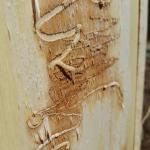 Emerald Ash Borer: (Agrilus planipennis, EAB) A new detection of emerald ash borer was confirmed recently by the Massachusetts Department of Conservation and Recreation in a new community in Norfolk County, MA. A map of this location and others known across the state may be found here: https://ag.umass.edu/fact-sheets/emerald-ash-borer .
Emerald Ash Borer: (Agrilus planipennis, EAB) A new detection of emerald ash borer was confirmed recently by the Massachusetts Department of Conservation and Recreation in a new community in Norfolk County, MA. A map of this location and others known across the state may be found here: https://ag.umass.edu/fact-sheets/emerald-ash-borer .
This wood-boring beetle readily attacks ash (Fraxinus spp.) including white, green, and black ash and has also been found developing in white fringe tree (Chionanthus virginicus) and most recently, has been reported in cultivated olive (Olea europaea). Adult insects of this species will not be present at this time of year. Signs of an EAB infested tree may include (at this time) D-shaped exit holes in the bark (from adult emergence in previous years), “blonding” or lighter coloration of the ash bark from woodpecker feeding (chipping away of the bark as they search for larvae beneath), and serpentine galleries visible through splits in the bark, from larval feeding beneath. Positive identification of an EAB-infested tree may not be possible with these signs individually on their own.
For further information about this insect, please visit: https://ag.umass.edu/fact-sheets/emerald-ash-borer . If you believe you have located EAB-infested ash trees, particularly in an area of Massachusetts not identified on the map provided, please report here: http://massnrc.org/pests/pestreports.htm .
- European Pine Sawfly: Neodiprion sertifer caterpillars will be active roughly between 78-220 GDD, base 50°F. The primary host in MA is Mugo pine but it can be found on Scots, red, jack, and Japanese red pine and is also found on white, Austrian, ponderosa, shortleaf, and pitch pine when near the aforementioned species. This dark colored caterpillar feeds in tight groups and small numbers can be pruned or plucked out of host plants and destroyed. Larger numbers can be treated with an insecticidal soap spray when the caterpillars are still small. Spinosad products can be used whenever the caterpillars are actively feeding, usually by mid-May and when caterpillars are still small. Bacillus thuringiensis Kurstaki is not effective against sawflies.
- Forest Tent Caterpillar: Malacosoma disstria egg hatch will occur between 192-363 GDD’s, base 50°F, which typically coincides with sugar maple bud break. Scout for and prune out or otherwise remove any reachable forest tent caterpillar egg masses, which can hold 100’s of eggs, on susceptible hosts such as oak, birch, ash, maple, elm, poplar, and basswood at this time.
- Hemlock Looper: Two species of geometrid moths in the genus Lambdina are native insects capable of defoliating eastern hemlock, balsam fir, and white spruce. Adult moths lay their eggs on the trunk and limbs of hosts in September and October and eggs will hatch by late May or early June. Monitor susceptible hosts for small, inch-worm like caterpillars. Where populations are low, no management is necessary.
- Hemlock Woolly Adelgid: Adelges tsugae is present on eastern and Carolina hemlock. Infested trees may be treated with foliar sprays in late April to early May, using Japanese quince as a phenological indicator. Look for the females, covered in a white, woolly, waxy material and settled at the base of hemlock needles.
- Imported Willow Leaf Beetle: Plagiodera versicolora overwintered adults are present and have been reported as active and found on willow foliage on 5/2/2018 in Hanson, MA. Adult beetles will chew holes and notches in the leaves of willow. Egg laying will continue through the end of this month. Females lay yellow eggs in clusters on the undersides of leaves. Larvae are slug-like and bluish-green in color. They will feed in clusters and skeletonize the leaves. Most plants can tolerate the feeding from this insect, and foliage will appear brown. Repeated yearly feeding can be an issue, in which case management of the young larvae may be necessary. Take care with treatment in areas near water.
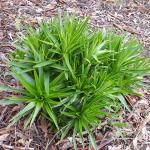
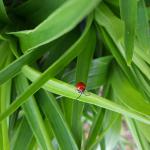
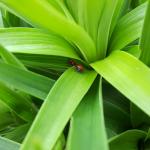 Lily Leaf Beetle: Lilioceris lilii overwintering adults have been spotted by scouts in central Massachusetts (Worcester County) and adult beetles were seen feeding on and hiding in new host plant foliage in Amherst, MA on 5/2/2018. Adults overwintered in sheltered places and are now active with the warm temperatures. As soon as susceptible hosts such as Lilium spp. (Turk’s cap, tiger, Easter, Asiatic, and Oriental lilies) and Fritillaria spp. break through the ground, the adult lily leaf beetles are known to feed on the new foliage. (Note: daylilies are not hosts.) Typically, in May, mating will occur and each female will begin to lay 250-450 eggs in neat rows on the underside of the foliage. If there are only a few plants in the garden, hand picking and destroying overwintering adults can help reduce local garden-level populations at this time.
Lily Leaf Beetle: Lilioceris lilii overwintering adults have been spotted by scouts in central Massachusetts (Worcester County) and adult beetles were seen feeding on and hiding in new host plant foliage in Amherst, MA on 5/2/2018. Adults overwintered in sheltered places and are now active with the warm temperatures. As soon as susceptible hosts such as Lilium spp. (Turk’s cap, tiger, Easter, Asiatic, and Oriental lilies) and Fritillaria spp. break through the ground, the adult lily leaf beetles are known to feed on the new foliage. (Note: daylilies are not hosts.) Typically, in May, mating will occur and each female will begin to lay 250-450 eggs in neat rows on the underside of the foliage. If there are only a few plants in the garden, hand picking and destroying overwintering adults can help reduce local garden-level populations at this time.- Snowball Aphid: Neoceruraphis viburnicola becomes active on certain species of viburnum roughly between 148-298 GDD’s or around redbud bloom. This insect is particularly noticeable on V. opulus, V. prunifolium, and V. acerifolia. Stem mothers, appearing blueish-white, can be found in curled up and distorted foliage. Damage caused by this insect pest is mostly aesthetic.
- Spotted Lanternfly: (Lycorma delicatula, SLF) is not known to occur in Massachusetts. This insect is a member of the Order Hemiptera (true bugs, cicadas, hoppers, aphids, and others) and the Family Fulgoridae, also known as planthoppers. This insect is a non-native species first detected in the United States in Berks County, Pennsylvania and confirmed on September 22, 2014. Until November 2017, this invasive insect was only known to Pennsylvania. It has now been reported from Delaware (November 20, 2017), New York (November 29, 2017), and most recently in Virginia (January 10, 2018). The Delaware Department of Agriculture announced the finding of a single female spotted lanternfly in New Castle County in the Wilmington, Delaware area. At this time, officials in Delaware note that it is unclear if this individual was an accidental hitchhiker, or evidence of an established population in the state. For more information about the find in Delaware, visit: https://news.delaware.gov/2017/11/20/spotted-lanternfly-confirmed-delaware/ . The New York State Department of Agriculture and Markets reported on November 29, 2017 the finding of a single dead individual spotted lanternfly in the state from earlier in the month. A single dead specimen was confirmed at a facility in Delaware County, New York, which is located south-west of Albany. The NYS Dept. of Agriculture and Markets states that this dead individual may have come in on an interstate shipment. For more information about the find in New York, visit: https://www.agriculture.ny.gov/AD/release.asp?ReleaseID=3637 . Most recently, Virginia Cooperative Extension announced the finding of a spotted lanternfly population in Frederick County, Virginia, on January 10, 2018. It was noted that at the location in Virginia, numerous adult lanternflies and egg masses were discovered, in addition to more at another site approximately 400 yards away. For more information about the find in Virginia, visit: https://ext.vt.edu/agriculture/commercial-horticulture/spotted-lanternfly.html .
The spotted lanternfly is considered native to China, India, and Vietnam. It has been introduced as a non-native insect to South Korea and Japan, prior to its detection in the United States. In South Korea, it is considered invasive and a pest of grapes and peaches. The spotted lanternfly has been reported from over 70 species of plants, including the following: tree of heaven (Ailanthus altissima) (preferred host), apple (Malus spp.), plum, cherry, peach, apricot (Prunus spp.), grape (Vitis spp.), pine (Pinus spp.), pignut hickory (Carya glabra), sassafras (Sassafras albidum), serviceberry (Amelanchier spp.), slippery elm (Ulmus rubra), tulip poplar (Liriodendron tulipifera), white ash (Fraxinus americana), willow (Salix spp.), American beech (Fagus grandifolia), American linden (Tilia americana), American sycamore (Platanus occidentalis), big-toothed aspen (Populus grandidentata), black birch (Betula lenta), black cherry (Prunus serotina), black gum (Nyssa sylvatica), black walnut (Juglans nigra), dogwood (Cornus spp.), Japanese snowbell (Styrax japonicus), maple (Acer spp.), oak (Quercus spp.), and paper birch (Betula papyrifera).
The adults and immatures of this species damage host plants by feeding on sap from stems, leaves, and the trunks of trees. In the springtime in Pennsylvania (late April - mid-May) nymphs (immatures) are found on smaller plants and vines and new growth of trees and shrubs. Third and fourth instar nymphs migrate to the tree of heaven and are observed feeding on trunks and branches. Trees may be found with sap weeping from the wounds caused by the insect’s feeding. The sugary secretions (excrement) created by this insect may coat the host plant, later leading to the growth of sooty mold. Insects such as wasps, hornets, bees, and ants may also be attracted to the sugary waste created by the lanternflies, or sap weeping from open wounds in the host plant. Host plants have been described as giving off a fermented odor when this insect is present.
Adults are present by the middle of July in Pennsylvania and begin laying eggs by late September and continue laying eggs through late November and even early December in that state. Adults may be found on the trunks of trees such as the tree of heaven or other host plants growing in close proximity to them. Egg masses of this insect are gray in color and look similar to gypsy moth egg masses.
Host plants, bricks, stone, lawn furniture, recreational vehicles, and other smooth surfaces can be inspected for egg masses. Egg masses laid on outdoor residential items such as those listed above may pose the greatest threat for spreading this insect via human aided movement.
For more information about the spotted lanternfly, visit this fact sheet: https://ag.umass.edu/landscape/fact-sheets/spotted-lanternfly .
- Spruce Spider Mite: Oligonychus ununguis is a cool-season mite that becomes active in the spring from tiny eggs that have overwintered on host plants. Hosts include spruce, arborvitae, juniper, hemlock, pine, Douglas-fir, and occasionally other conifers. This particular species becomes active in the spring and can feed, develop, and reproduce through roughly June. When hot, dry summer conditions begin, this spider mite will enter a summer-time dormant period (aestivation) until cooler temperatures return in the fall. This particular mite may prefer older needles to newer ones for food. When damaging spruce spider mite populations are known from last season, dormant oil applications can be made (when temperatures are appropriate according to label instructions) between 7-121 GDD’s, base 50°F. Magnification is required to view spruce spider mite eggs. Tapping host plant branches over white paper may be a useful tool when scouting for spider mite presence. (View with a hand lens.) Spider mite damage may appear on host plant needles as yellow stippling and occasionally fine silk webbing is visible.
- Viburnum Leaf Beetle: Pyrrhalta viburni is a beetle in the family Chrysomelidae that is native to Europe, but was found in Massachusetts in 2004. This beetle feeds exclusively on many different species of viburnum. This insect overwintered in the twigs of the host plant as eggs, which hatch soon after bud break. Now is the time to inspect susceptible plants (including but not limited to viburnum such as V. dentatum, V. nudum, V. opulus, V. propinquum, and V. rafinesquianum) for over-wintered eggs on stems toward branch tips. Inspect branches for egg laying sites created by female viburnum leaf beetles last season. These will appear as small holes approximately 1 mm. in diameter that have been capped with a lid made of chewed bark and excrement, which may appear raised above the surface of the twig. Larvae, when they are present, may be treated with a product containing spinosad once they appear soon after bud break. Larvae are typically first present between 80-120 GDD’s, base 50°F, which often coincides with redbud bloom. Some viburnum have been observed to have varying levels of resistance to this insect, including but not limited to V. bodnantense, V. carlesii, V. davidii, V. plicatum, V. rhytidophyllum, V. setigerum, and V. sieboldii. More information about viburnum leaf beetle may be found at http://www.hort.cornell.edu/vlb/ .
- White Spotted Pine Sawyer (WSPS): Monochamus scutellatus will be pupating this month and adults can emerge in late May throughout July, depending on local temperatures. This is a native insect in Massachusetts and is usually not a pest. Larvae develop in weakened or recently dead conifers, particularly eastern white pine (Pinus strobus). However, the white spotted pine sawyer looks very similar to the invasive Asian Longhorned Beetle, Anoplophora glabripennis, ALB. ALB adults do not emerge in Massachusetts until July and August. Beginning in July, look for the key difference between WSPS and ALB adults, which is a white spot in the top center of the wing covers (the scutellum) on the back of the beetle. White spotted pine sawyer will have this white spot, whereas Asian longhorned beetle will not. Both insects can have other white spots on the rest of their wing covers; however, the difference in the color of the scutellum is a key characteristic. See the Asian longhorned beetle entry above for more information about that non-native insect.
- Woolly Elm Aphid: Eriosoma americanum females lay a single egg in the cracks and crevices of elm bark, where the egg overwinters. Eggs hatch on elm in the spring as leaves are unfolding. Aphids may be active from 121-246 GDD’s, base 50°F on elm. A young, wingless female hatched from the egg feeds on the underside of leaf tissue. This female aphid matures and gives birth to 200 young, all females, without mating. These aphids feed, and the elm leaf curls around them and protects them. By the end of June, winged migrants mature and find serviceberry hosts. Another set of females is produced. These new females crawl to and begin feeding on the roots of serviceberry. Multiple generations occur on the roots of serviceberry through the summer.
Concerned that you may have found an invasive insect or suspicious damage caused by one? Need to report a pest sighting? If so, please visit the Massachusetts Introduced Pests Outreach Project: http://massnrc.org/pests/pestreports.htm .
A note about Tick Awareness: deer ticks (Ixodes scapularis), the American dog tick (Dermacentor variabilis), and the lone star tick (Amblyomma americanum) are all found throughout Massachusetts. Each can carry their own complement of diseases. Anyone working in tick habitats (wood-line areas, forested areas, and landscaped areas with ground cover) should check themselves regularly for ticks while practicing preventative measures. Have a tick and need it tested? Visit the web page of the UMass Laboratory of Medical Zoology (https://www.tickreport.com/) and click on the red Test a Tick button for more information.
Reported by Tawny Simisky, Extension Entomologist, UMass Extension Landscape, Nursery, & Urban Forestry Program
Weeds
Landscape mulch should be the first defense against weeds in landscape beds. Application of mulch can be done at the beginning of the season before summer annual weeds germinate. Freshly mulched landscape beds will not require a pre-emergence herbicide application because the fresh mulch should supply adequate control of summer annual weeds in the short term. Pre-emergence herbicide application should be considered for mulch areas that have not been freshly mulched or a bit later in the season. Pre-emergence herbicides should be applied on top of landscape mulches not underneath. Compost is not recommended as a mulching material.
Inspect areas of landscape where new trees or shrubs, especially those that were field grown, have been planted in the last year. Look for perennial weeds that may be growing from the root ball. Canada thistle, mugwort, quackgrass, bindweed and horsenettle are some of the possible culprits. Application of glyphosate as a directed spray should be done at the first sign of new season growth.
When scouting for weed in the landscape, observe areas underneath and around bird feeders. Some of the most interesting weeds that are sent to me in the UMass Extension Diagnostic Lab come from these areas. Many of these plants are from other regions of the country and have the potential to be aggressive and pernicious.
Treat winter annual and perennial weeds in ornamental beds with glyphosate (Roundup Pro or equivalent) and glufosinate (Finale). These applications are easier if done now before woody ornamentals leaf-out. The new growth of herbaceous perennial ornamentals can be very susceptible to spray drift, so exercise extreme caution. Non-chemical products containing clove oil, citric acid, acetic acid or orange extract can be used on small winter annuals but not on large winter annuals or perennials. Remember these organic/non-chemical products do not translocate and will not control established perennial weeds but will control young winter annual weeds. Many winter annuals are just beginning to flower and have not set seed so should be controlled now.
Common landscape winter annual weeds being observed now are:
mouse-ear cress Arabidopsis thaliana
thymeleaf sandwort Arenaria serpyllifolia
downy brome Bromus tectorum
shepherd's-purse Capsella bursa-pastoris
bittercress Cardamine hirsuta
sticky chickweed Cerastium viscosum
horseweed Conyza canadensis
spring whitlowgrass Draba verna
henbit Lamium amplexicaule
red deadnettle Lamium purpureum
field pepperweed Lepidium campestre
Virginia pepperweed Lepidium virginicum
pineappleweed Matricaria matricariodes
annual bluegrass Poa annua
knawel Scleranthus annuus
common chickweed Stellaria media
field pennycress Thlaspi arvense
corn speedwell Veronica arvensis
purslane speedwell Veronica peregrina
Learn more about these weed species by visiting UMass Extension's Weed Herbarium: http://extension.umass.edu/landscape/weed-herbarium
Weed of the Week: whitlowwort or spring whitlow grass, Draba verna
A member of the Mustard Family, Brassicaceae (Cruciferae), is in flower now. As a winter annual weed it will complete its life cycle as summer arrives. In mulched landscape area a layer of fresh mulch will smother the weed. In hardscape areas a treatment of glyphosate or one of the non-chemical products mentioned above can be used. Photo and detailed identification information and be found at https://extension.umass.edu/landscape/weeds/draba-verna
Report by Randy Prostak, Weed Specialist, UMass Extension Landscape, Nursery and Urban Forestry Program
Plant of the Week
Saucer magnolia is a prolific bloomer as long as it’s not damaged by late spring frosts.
https://extension.umass.edu/plant-identification/saucer-magnolia
Report by Mandy Bayer, Extension Assistant Professor of Sustainable Landscape Horticulture, UMass Stockbridge School of Agriculture
Other Relevant News/Pest Alerts
What are the most common shrubs used in Massachusetts landscapes? What shrubs are underutilized?
Please let us know in a brief survey! https://goo.gl/forms/OXe9ArhYFWe8QJAo1
Information from this survey will be used to inform research and educational efforts at UMass.
Additional Resources
To receive immediate notification when the next Landscape Message update is posted, be sure to join our e-mail list and follow us on Facebook and Twitter.
For a complete listing of upcoming events, see our Upcoming Educational Events page.
For commercial growers of greenhouse crops and flowers - Check out UMass Extension's Greenhouse Update website
For professional turf managers - Check out Turf Management Updates
For home gardeners and garden retailers - Check out home lawn and garden resources. UMass Extension also has a Twitter feed that provides timely, daily gardening tips, sunrise and sunset times to home gardeners, see https://twitter.com/UMassGardenClip
Diagnostic Services
A UMass Laboratory Diagnoses Landscape and Turf Problems - The UMass Extension Plant Diagnostic Lab is available to serve commercial landscape contractors, turf managers, arborists, nurseries and other green industry professionals. It provides woody plant and turf disease analysis, woody plant and turf insect identification, turfgrass identification, weed identification, and offers a report of pest management strategies that are research based, economically sound and environmentally appropriate for the situation. Accurate diagnosis for a turf or landscape problem can often eliminate or reduce the need for pesticide use. For sampling procedures, detailed submission instructions and a list of fees, see Plant Diagnostics Laboratory
Soil and Plant Nutrient Testing - The University of Massachusetts Soil and Plant Nutrient Testing Laboratory is located on the campus of The University of Massachusetts at Amherst. Testing services are available to all. The function of the Soil and Plant Nutrient Testing Laboratory is to provide test results and recommendations that lead to the wise and economical use of soils and soil amendments. For complete information, visit the UMass Soil and Plant Nutrient Testing Laboratory web site. Alternatively, call the lab at (413) 545-2311.
Ticks are active at this time! Remember to take appropriate precautions when working and playing outdoors, and conduct daily tick checks. UMass tests ticks for the presence of Lyme disease and other disease pathogens. Learn more
